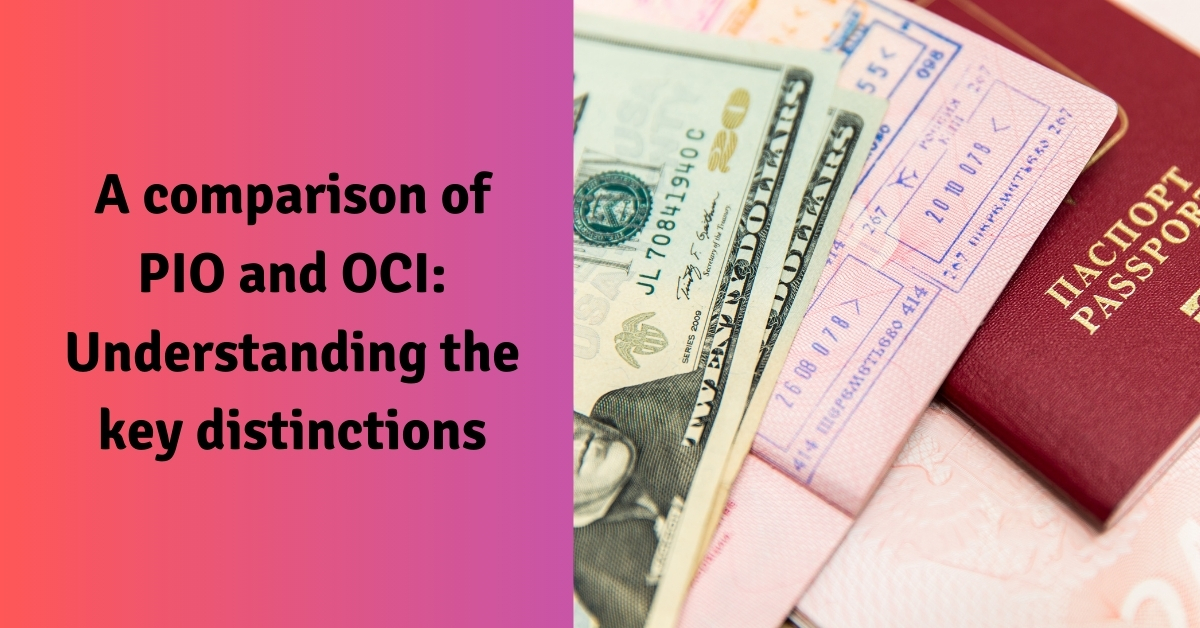A comparison of PIO and OCI: Understanding the key distinctions

The Indian government has recently updated its policies for overseas citizens and people of Indian origin, aiming to better connect with the global Indian community. One major change has been merging the Person of Indian Origin (PIO) and Overseas Citizenship of India (OCI) card schemes, along with new rules and benefits for OCI cardholders. This has led to much discussion and interest.
In this blog, we’ll explain what PIO and OCI are, their benefits and drawbacks, and the differences between them. We’ll also look at how each status works in practice and compare them with Non-Resident Indian (NRI) status to help you decide which is best for you.
What is PIO?
A Person of Indian Origin (PIO) is someone who isn’t an Indian citizen but has Indian ancestry. This status was created to help people of Indian descent keep a connection with India, even if they live abroad. The PIO card, introduced in 1999, was a way to recognize the Indian diaspora’s contributions and maintain ties with them.
What are the Eligibility Criteria for PIO?
To get a PIO card, you needed to meet these requirements:
- You or your ancestors must have been Indian citizens at some point.
- You must not be a citizen of Pakistan, Bangladesh, Sri Lanka, Bhutan, Afghanistan, China, Iran, Nepal, or any other country specified by the Indian government.
- Spouses of Indian citizens or PIO cardholders could also apply.
What are the Benefits of PIO Status?
PIO cardholders enjoyed several benefits, such as:
- They could travel to India without a visa, making it easier for spontaneous visits.
- They could stay in India for up to 15 years without additional paperwork.
- They had access to the same economic and educational opportunities as NRIs, including enrolling in educational institutions and owning property in India.
What are the Documentation Requirements for PIO?
To apply for a PIO card, you needed to provide:
- A current passport, valid for at least six months.
- An old Indian passport, birth certificate, or school leaving certificate to show Indian origin.
- Recent passport-sized photos as required by the issuing authority.
- Proof of address, like utility bills, bank statements, or lease agreements.
- A certified copy of the marriage certificate if applying because of a spouse’s Indian origin.
- Documents proving the spouse’s Indian origin (like an Indian passport).
- Affidavits if needed to clarify details or provide more proof of relationships.
- Completed application forms from the Indian consulate or embassy.
What is OCI?
The Overseas Citizen of India (OCI) card is a type of permanent residency for people of Indian origin and their spouses. Launched in 2005, the OCI card gives non-resident Indians benefits similar to Indian citizens but does not grant full citizenship. This card is available to citizens of all countries except those born in Pakistan and Bangladesh.
What are the Eligibility Criteria for OCI?
To get an OCI card, you must:
- Be a former Indian citizen or a descendant of someone who was.
- Be eligible for Indian citizenship on or after January 26, 1950.
- Be a minor child of such a person.
- Be the spouse of an Indian citizen or OCI cardholder, provided the marriage is at least two years old.
What are the Benefits of OCI Status?
OCI cardholders receive several benefits, including:
- The ability to travel to India without a visa, with unlimited visits allowed.
- The right to work in most professions in India, except for government jobs and other restricted categories.
- The ability to acquire, own, and transfer property in India, except for agricultural and plantation properties.
- Access to educational institutions and eligibility to apply for various scholarships, making it easier to study in India.
What are the Documentation Requirements for OCI?
To apply for an OCI card, you need:
- A current passport with at least six months validity.
- A previous Indian passport (if available).
- Proof of Indian origin (like a birth certificate or ancestral documents).
- Copies of the parents’ or grandparents’ Indian passports or birth certificates.
- Submission of biometric data (fingerprints and a digital photo) during the application.
- Both parents’ signatures on the application if it’s for a minor.
- Additional medical documents may be required for applicants over the age of 50.
FAQs’
Q1: Can PIO cardholders apply for Indian citizenship?
Ans- No, PIO cardholders cannot apply for Indian citizenship, but they can enjoy many benefits similar to NRIs, like traveling to India without a visa.
Q2: Are OCI and PIO the same now?
Ans- Yes, the PIO card scheme has been merged with the OCI card scheme. Existing PIO cardholders are now considered OCI cardholders and enjoy the benefits under the OCI scheme.
Q3: Can OCI cardholders vote in Indian elections?
Ans- No, OCI cardholders do not have the right to vote in Indian elections or hold public office.
Q4: Are there any restrictions on the types of properties OCI cardholders can own in India?
Ans- Yes, OCI cardholders cannot own agricultural land or plantation properties in India. They can only own residential or commercial properties.
Q5: Can an OCI cardholder work in India?
Ans- Yes, OCI cardholders can work in India in most professions, except for government jobs and other restricted categories.
Q6: What happens if an OCI cardholder’s marriage to an Indian citizen ends?
Ans- If the marriage ends in divorce, the OCI status granted based on that marriage may be revoked.
Q7: Can an OCI cardholder open a bank account in India?
Ans- Yes, OCI cardholders can open and maintain bank accounts in India.
Q8: Do OCI cardholders have to register with the Foreigners Regional Registration Office (FRRO)?
Ans- No, OCI cardholders do not need to register with the FRRO for any length of stay in India.
Q9: Can children of OCI cardholders get OCI status?
Ans- Yes, children of OCI cardholders can apply for OCI status if they meet the eligibility criteria.
Q10: Can OCI cardholders participate in India’s “Make in India” initiatives?
Ans- Yes, OCI cardholders can participate in various business and investment opportunities, including the “Make in India” initiatives, subject to certain restrictions.



